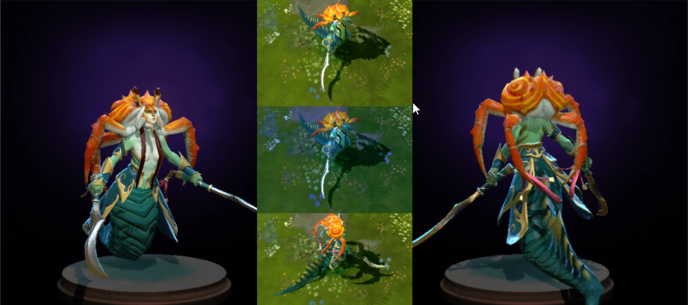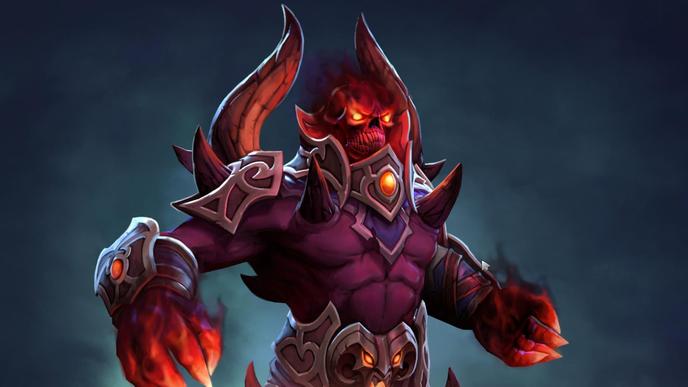Dota 2, Accept That You’re a Silly Game
Dota 2 is a remarkably silly game. Both as a competitive game and as a world with a backstory and lore and over a hundred characters, not much of anything makes sense. If you ever decide to play it, at some point you’ll wonder why all of these ridiculous characters are fighting each other. Why are certain heroes split up into “Radiant” or “Dire” sides? You might wonder why so many of the game’s minor interactions work the way they do: what spells circumvent the effects of the Black King Bar, which is supposed to negate the effects of spells? You won’t get an easy answer, because the game offers so few.
Luckily, the lore of Dota’s world is sparse, vague and ultimately not all that important. You can play dozens, hundreds, thousands of matches online without knowing any of these character’s motivations or backgrounds and still enjoy it (when you’re not being harassed by teenagers, of course). This is as it should be: Dota 2 is a competitive game, after all, so the less unnecessary knowledge you’re burdened with, the better.
But while the “story” aspects of Dota 2 are mostly for fun, it’s crucial when it comes to cosmetic items, the money-making machine that keeps the whole thing running the way it has. Unlike other games in its genre, Dota 2 doesn’t charge for heroes or anything gameplay-related, instead opting to have users pay to modify just about any part of the interface, items, or characters they play as in the game. And this is where both Valve and its fans takes the game a little too seriously, where they could instead choose to have more fun and make the game appeal to a wider audience.
Dota 2 is, in many ways, a game built by its fans. Balance patches often address complaints about which heroes are too powerful, and many bugs and interface issues are first found by players. And with a few exceptions, players make the items bought and sold on its store or the Steam community market. Because this is where the money comes from, Valve has guidelines in place so users know what will and won’t work for the game, and what their odds are for getting accepted. These guidelines include the obvious rules (no copyright infringement, no sexually explicit stuff), as well as some practical ones: any outfit still has to set the character apart from all the others.
But there are also thematic guidelines for what fits in with the “look” of the rest of game, and these guidelines are harder to parse. On the workshop page, Valve says what fits the game is “a tricky question we grapple with daily. Items should maintain the personality of the character.” In essence, a set can’t go too crazy in one direction and make the character look completely different. That’s understandable. But there are also concerns about whether or not a set of items will be consistent with the game’s lore, or if it will maintain consistency with the character.
This is another aspect that sets Dota 2 apart from games like League of Legends and Heroes of the Storm: it keeps the tone of the items it sells to players in check. The latter two, for example, aren’t afraid to turn a ninja into a soccer player, or give pajamas to vikings. Other games seem to veer towards making outfits that are fun rather than those that would “fit” with the character, and Dota 2’s general dismissal of these sorts of outfits shows that it might be a little too serious.
This seems like a strange step to me, considering that Valve has a fairly laissez-faire approach to the game otherwise. The company stands by the idea of allowing for the widest range of experiences, even if that means not everyone has a good one. In the past, it’s defended the lack of a “surrender” option (which League of Legends has) by saying it would limit the range of experiences players could have with the game. It also doesn’t explain most of the balance patches the way companies like Blizzard or Bungie do, preferring to let players learn why certain changes happened and develop new play styles on their own. That they would be so strict about what “fits” the character seems to go against this kind of thinking.
These guidelines, along with the company’s lack of communication, have caused problems in the past. Take, for example, the case of the Alpine Stalker cosmetic set, for the character Ursa. It was added to the game’s store on August 15th, 2012 and seemed to match most of the aesthetic guidelines laid out by Valve. But it was removed just six days later, after fans complained that it did not meet thematic guidelines. (A lot of people just thought it was a bad look for the character). People who bought it in that short time are lucky: because any items that were no longer available in any form were at one point branded as “Immortal” items, the set became valuable for its scarcity, selling for prices as high as $400 per item in the set. The value is really beside the point though; if you want your Ursa to don a cowboy hat, you’re out of luck.
The effects of the Alpine Stalker fiasco have lingered; there are several sets each year that, from an outsider’s’ view, don’t make the cut simply because they don’t seem to fit with the game’s lore, or because they’re not consistent with the aesthetic guidelines Valve has set forth. Users have to submit the sets before they’re accepted, of course, but they’re also available to view publicly while waiting for approval. This leads to many sets being scoffed at for not fitting the lore or being too silly. Sometimes you’ll see a set you like and know it won’t get in because of this. Other times, you’ll see a cat-themed set go on the store and wonder how it got there while others languished in submittal hell.


